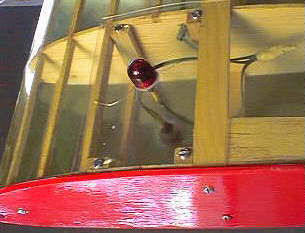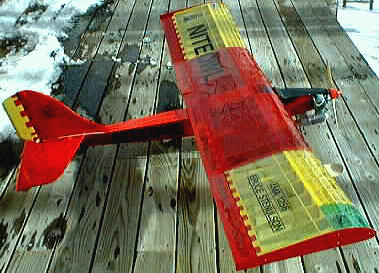
Bruce Stenulson with the NITEOWL at Dry Lake near Fairplay, at sunset, Sat., Dec. 28, 1996
Specifications:
Wingspan: 82"
Wing Chord: 16"
Total Wing Area: 1312 sq. in. = 9.11 sq. ft.
Weight, ready to fly, dry, with Rx Battery: under 8 pounds!
Fuselage overall length: 60"
Ailerons: each 21"x2-1/2"
Flaps: each 14"x2-1/2"
Horizontal Stabilizer span: 26"
H. Stab + Elevator total area: 245 sq. in.
Elevator chord: 3"
Airfoil: Origional; high lift, Phillips entry, flat bottom, with "Turbulator" Spar structure
Engine: Thunder Tiger Pro .61, side mounted, with Resonant Exhaust Extractor system
Landing Gear: Taildragger: Bent 5/32" music wire & 1/8" music wire, 24" on centers
Also designed to be flown with 42" Applied Technology Floats
Tailgear: Tailskid wire, 3/32 dia.
Skis: 4-1/4"x15", 1/8" birch ply, shaped
Radio System: Airtronics RADIANT
Light System Battery: 2 cell SANYO KR1700AE ; up to 50 minutes light time @ 280mA/bulb
Lighting system control: Mechanical switch; RC control from LG channel optional.
Covering Material used: Goldberg Ultracote, Transparent Red & Transparent Yellow, &Flourescent Red Trim underside.
There is a 12" wide fixed panel at the center of the wing's trailing edge, between the flaps. By leaving the area in front of the center of the horizontal stabilizer clear of the flaps, there is virtually NO balooning noticed when activating the flaps; even with full flaps deployed at higher throttle settings! This could also be a characteristic of the 16" wing chord coming into play; it's the best Flaps handling I've experienced yet!
All photos copyright 1997 by Bruce Stenulson; please Email me and ask if you would like to use them elswhere; it's not out of the question!
Contact Bruce Stenulson for further information by Email at stenulson@amigo.net, or call 719-836-2489


Carbon Fiber Control rods, with standoffs to minimize flex; #4-40 Stainless Steel screws as control horns. Ultrakote Hinging used on all control surfaces


The open structure and turbulator spars, combined with the airfoil's design, allow for extremely slow flying without having the ailerons going "soft"; there is NO Curvature in the aft 55% of the airfoil's top surface. My observations of various RC planes flying in the thinner air at high altitude lead me to believe that airfoils which have curvature farther back on the top surface are more prone to low speed separation in this area. Turbulator spars are said to pruduce a turbulated surface layer air flow, which is less prone to separation as speeds decrease.The Wing tip plates also help the slow speed characteristics of this wing. With a wing loading of around 14 oz./Sq. Ft., the combination of all of these factors results in a wing with an extremely slow stall speed, even at 10,000 feet, and ailerons which retain their effectiveness in extremely slow, full flap landings!


This front view shows the side mounted engine, which allows routing the resonant exhaust extractor (& crud diverter) under the belly. The spinner fares into the forward structure cleanly; I use flaps for added lift and drag when desired, and try to keep the rest of the structure fairly clean, drag-wise.
The "Resonant Exhaust Extractor" is a tuned length (volume), consisting of 12" of 1/2" ID neoprene, slid 1" over an 11" long piece of 1/2" OD brass tubing. Overall length is 22", which is then slid onto the end of the muffler as far as it goes. This length was tested to work on both the ASP .61 and .75 engines, as well as the Thunder Tiger Pro .61 mounted on this aircraft. RPM, propeller used, and flying environment may affect the optimum length on your system, and can be determined by using two sliding pieces of brass tubing . Internal Volume is the variable; the result on these engines is a quieter running 2 cycle engine, with all of the exhaust oil back behind the wing & underneath, with NO LOSS IN RPM from running with the stock muffler.

The photos on this page were taken with the OLYMPUS D-300L Digital camera; some editing, cropping, and adjusting has been done on most of them.
Return to the RC FLIGHT main page.
Return to Applied Technology's web site Home Page
Web sight designed and maintained by Bruce Stenulson, Applied Technology, Fairplay, Colorado. (c) 1997 - All rights reserved.